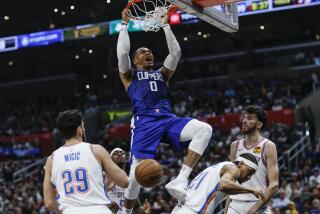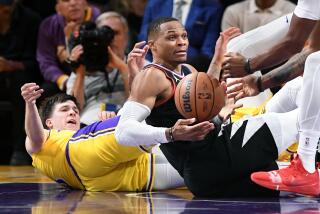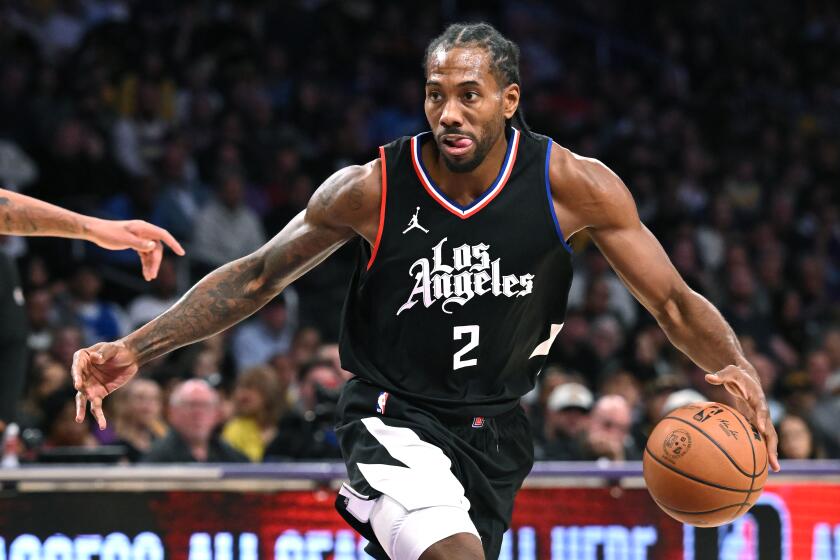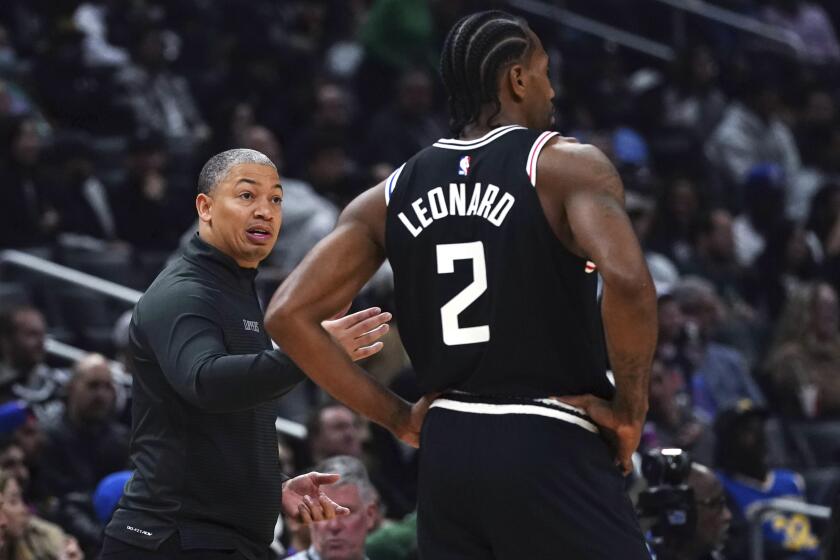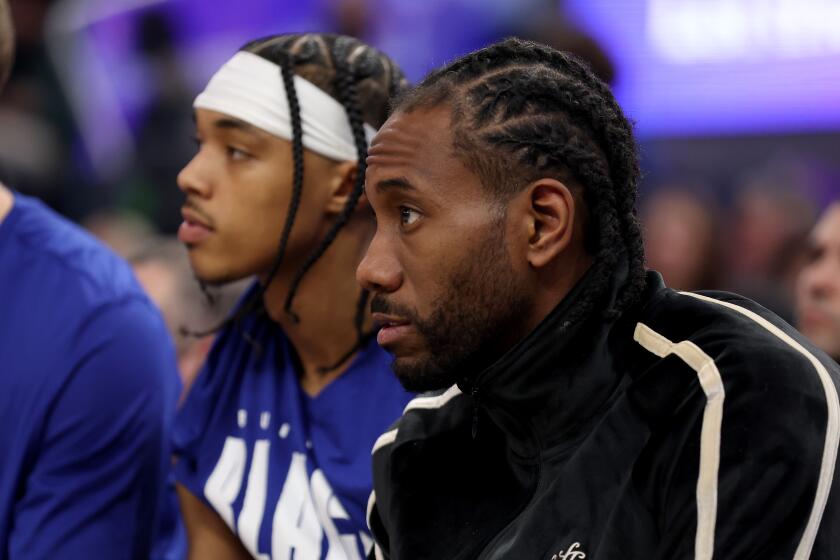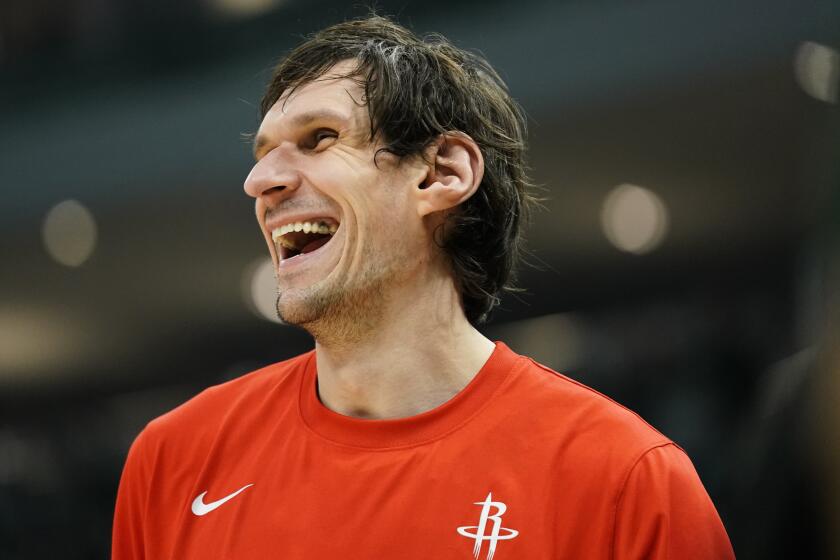Doc Rivers is defying conventional NBA wisdom, and the Clippers like it
When an official calls a foul on the Clippers, coach Doc Rivers’ first instinct isn’t to look down his bench for a substitution.
“It’s hard to foul out in an NBA game, to be honest,” he said. “I’ve always thought that. Why take a guy out who has two?”
The depth of his roster has only emboldened him. Ten Clippers who have appeared in at least half the team’s games are averaging 10 minutes or more. The rotation has gone at least 10 deep in every game this season, and has even stretched to as many as 13 a few times.
Depth hasn’t changed Rivers’ approach to all foul-related decisions. He needs players who close games, such as reserves Lou Williams and Montrezl Harrell, to be available for the fourth quarter and might opt to shield them early.
Yet having options has allowed Rivers even more leeway in a season of quick whistles, triggered by officials’ renewed emphasis on allowing offensive players more freedom to move. Entering Sunday, only Phoenix (24.5) and Detroit (24.4) had been called for more fouls per game than the Clippers (24.2), who also have benefited from such calls, by drawing a league-high 25.4 fouls a game.
They drew 24 fouls Sunday and were called for just 13.
After earning four fouls in the first half against Brooklyn on Nov. 17, rookie Shai Gilgeous-Alexander emerged with the rest of the starting lineup at the start of the second half like nothing happened.
“We don’t need to worry about fouls because if a guy fouls out, we got another guy to put in,” Rivers said after the game.
Rivers reiterated that such thinking isn’t radical for him, but it can feel that way for players.
“The rule was once you get two, you gotta sit,” forward Tobias Harris said. “Usually a lot of other coaches, if you’ve got two fouls in the first half, especially the first quarter or early second quarter, they’re not going to put you back in until the third quarter. [Rivers] lets you play through the fouls. It’s a good thing because fouls can disrupt the rhythm a lot of time of a player, and Doc probably felt that way when he played, too.”
On eight occasions, a Clipper with five fouls has played more than 30 minutes; only Detroit, Houston, Memphis, Minnesota, Philadelphia, Phoenix, Sacramento and Utah have done that more often.
“I like it, personally,” Gilgeous-Alexander said. “It helps you play a little bit freer.”
Gortat back in the mix
The last time Marcin Gortat was in Portland, he’d lost his starting center job to Boban Marjanovic and hadn’t played in two straight games — and then he sat all 48 minutes during a Nov. 8 loss to the Trail Blazers.
In the eight games before the benching, Gortat averaged 3.6 points, 5.5 rebounds, 1.5 assists and shot 40%.
How times have changed.
Since Gortat returned to the rotation Nov. 10, he has averaged 7.6 points and 6.2 rebounds and is shooting 66.7%. That includes about five more offensive touches a game, including two more in the post.
One factor in Gortat’s benching was his tendency to run directly to the low block instead of setting “drag” screens and rolling to the basket — essentially doing what he’d become used to in Washington instead of consistently executing the Clippers’ plan for big men. It was no small mistake; screening defenders out of the play is one of his best skills even if it doesn’t appear in a box score.
“He’s really been better,” Rivers said. “He is really finding guys early in transition and rolling to the basket and that puts pressure on the defense and that’s where we’ve been getting all the pocket passes for him and the layups for him.”
Rebounding well
The Clippers finished Sunday percentage points ahead of Golden State for the top spot in the West, which came as no shock to a team that feels it can play with anyone.
One pleasant surprise, however, has been the Clippers’ rebounding. Despite ranking in the league’s bottom half in both offensive and defensive rebound percentage entering Sunday, the Clippers ranked 15th in overall rebounding percentage, having grabbed 50.4% of available rebounds.
“Rebounding was the one area going into the season we just didn’t know and we’ve done pretty well,” Rivers said.
Twitter: @andrewgreif
More to Read
Get our high school sports newsletter
Prep Rally is devoted to the SoCal high school sports experience, bringing you scores, stories and a behind-the-scenes look at what makes prep sports so popular.
You may occasionally receive promotional content from the Los Angeles Times.

